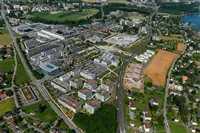 A recent discovery by a team at École polytechnique fédérale de Lausanne (EPFL) in Switzerland suggests that it is possible to create conductive pathways several atoms wide in a material, move them around at will and make them disappear.
A recent discovery by a team at École polytechnique fédérale de Lausanne (EPFL) in Switzerland suggests that it is possible to create conductive pathways several atoms wide in a material, move them around at will and make them disappear.
The approach – called adaptable electronics – is generating interest because of the many applications, including one chip performing the tasks of several different circuits. As an example, says the research team, a circuit assigned to process sound information could, when not being used for this purpose, be reassigned to process images. This, it adds, would allow electronic devices to be miniaturised.
A further benefit of the approach could be resilient circuits: if a chip is damaged, it could theoretically reconfigure itself using the components that remain intact.
Underpinning the work are ferroelectric materials, in which flexible conductive pathways can be generated by applying an electric field. When the current is applied, certain atoms move 'up' or 'down' – or polarisation. Recently, it has been seen that conductive pathways several atoms wide –'walls' – form between these polarised zones, but it has not been possible to control how these pathways form.
The EPFL researchers have shown the formation of walls on a film of ferroelectric material sandwiched between platinum components can be controlled and pathways created at given sites. "By applying electric fields locally on the metal part," said researcher Leo McGilly, "we were able to create pathways at different sites and move them. We couls also destroy them with a reverse electric field."
The research team has tested its work on isolated materials, but the next will be to develop a prototype reconfigurable circuit. McGilly concluded: "The fact that we can generate pathways wherever we want could allow us to imitate in the future phenomena that take place inside the brain, with the regular creation of new synapses. This could prove useful in reproducing the phenomenon of learning in an artificial brain."
Author
Graham Pitcher
Source: www.newelectronics.co.uk

